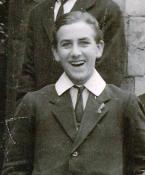
|
The King's School Canterbury |
Roll of Honour |
| Flying Officer James PIPE | |
|
31 Squadron, Royal Air Force Date of birth: 11th May 1898 Date of death: 1st January 1920 Died of wounds aged 21 Commemorated on the Karachi War Memorial |

|
| He was born at Harlesden in Middlesex on the 11th of May 1898 the eldest son of Major Alfred William Pipe, Royal Garrison Artillery Ret. and oil merchant, and Rose (nee Saxton) of 5 Woodburn Street, Irvine in Argyllshire, later of 63 West Cumberland Street, Glasgow. He was educated at Park View School, Godstone and at the King's School Canterbury where he was in Holme House from May 1912 to July 1914. He shared the Lower School Dictation Prize in 1913 and was a member of the 2nd Cricket XI in 1914 as well as playing a few games for the 1st Cricket XI the same year. He was a member of the Officer Training Corps from the 1st of August 1912. On leaving school he worked as an apprentice motor engineer at Halleys Industrial Motors Ltd of 116 St Vincent Street, Glasgow from 1913 to 1917 where he received three and a half years of training as an internal combustion engineer and two months as an electrical engineer. He trained on both motor and aircraft engines while he was with the company. He applied for a commission in the Royal Flying Corps on the 2nd of April 1917, in an application which was supported by the Reverend McDowall, Headmaster of the King's School Canterbury. He attested for service in the Royal Flying Corps at Winchester on the 14th of May 1917 and enlisted at South Farnborough as Private 76309 on the 20th of April 1917. At a medical examination, which took place there the following day, it was recorded that he was five feet seven and one half inches tall and that he weighed 128lbs. He was posted to the School of Aeronautics at Oxford on the 27th of July 1917. He was commissioned as a temporary 2nd Lieutenant on the General List for the Royal Flying Corps on the 30th of August 1917 and was confirmed in his rank on the 7th of January 1918. He was posted to Egypt on the 20th of September 1917 and joined 194 Training Squadron at El Amriya on the 7th of January 1918. He was qualified to fly a range of aircraft which included: - D.H.VI, Maurice Farman Short Horn, B.E.2C and 2E, B.E. 12H, RE8 and the Martinsyde 120hp and 160hp. He had also passed a course at the Aerial Gunnery School and was said to have "slight French". He was wounded in action on the 28th of September 1918. He was posted to 142 Squadron on the 31st of December 1918 and was posted from No. 17 Training Depot Squadron at El Ferdan to No. 16 Training Depot Squadron at Abu Sueir on the 2nd of March 1919. He joined 31 Squadron based at Risalpur, near Peshawar on the Northwest Frontier of India on the 13th of April 1919. The Squadron had been there for much of the war where they were involved in actions in suppressing hostile activities from rebel tribesmen along the India/Afghanistan border. In May 1919 a local warlord, Nadir Shah, was the leader of an uprising by local tribes in the southern part of Waziristan. He and his force of an estimated twelve thousand Pathan tribesmen had laid siege to the town of Thal in the Kuram Valley where General Eustace was holding the town with a force of some eight hundred men. On the 26th of May three aircraft from 31 Squadron were despatched to attack his forces there. Three more aircraft, of which one was flown by James Pipe, were despatched on the 28th of May. On the 1st of June they attacked the rebel forces, causing heavy casualties among them. The rebellion was ended three days later when a force of three thousand regular troops under General Dyer attacked the rebel camp at Yusuf Khel and put the rebels to flight. On the 31st of December 1919 James Pipe and an Aircraftsman 2nd Class took off from Risalpur in Bristol F2 Fighter E2538. While the aircraft was executing a climbing turn it stalled and crashed. Both men were injured and were taken to the British Station Hospital at Risalpur where James Pipe died from his injuries the following day. He was buried at Peshawar on the 2nd of January 1920. The cause of the crash was determined to have been "an error of judgement" by the pilot. |
|
| Holme House |
Back